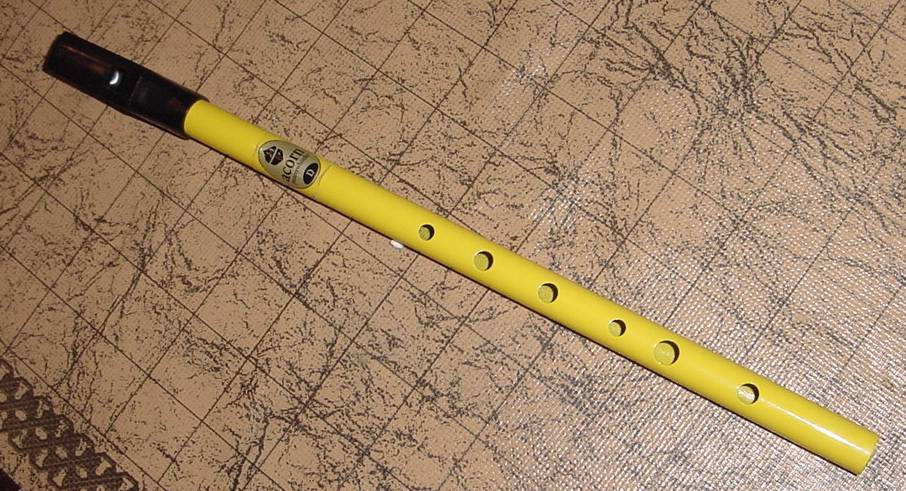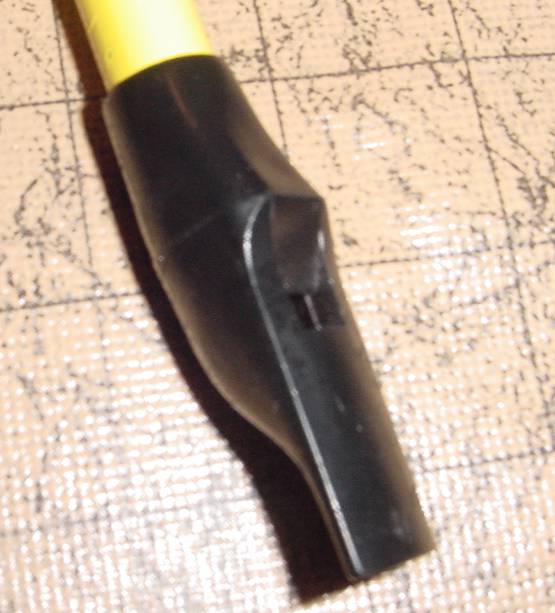Acorn Soprano D whistle Review
(Review written September 2004)
- Preface
- I got a yellow Acorn with a Peter Pickow Play Pennywhistle Now book and CD. By then, I was already in love with my various high-end whistles, and this one went straight into the whistle drawer. I've pulled it out and given it a go-through for the purposes of review. It is marketed as a "beginner's instrument" by the makers of Oak tinwhistles. Oak-Acorn, big kids-little kids. I get it..cute!
- At a Glance
- Whistle Reviewed
- Acorn Soprano D whistle
- Models Available
- a variety of colors, key of D
- How Acquired
- purchased from Melody Music
- Construction
- Reportedly brass tube, with a plastic mouthpiece.
- Price at Time of Review (in US Dollars unless otherwise noted)
- approx $9.00
- Available From
-
Amazon
- Appearance
- Almost all inexpensive whistles look nearly identical. Straight tubes, with a plastic mouthpiece. In fact, most inexpensive whistles have plastic mouthpieces that look similar to each other too. I imagine there's a certain amount of copying among the makers.
-

Here it is. I hate that beginner's tinwhistles (Acorn, Sweetone, etc) are painted in all kinds of garish colors. It makes them look like toys. Then again, I'm sure they're trying to market them to kids. I'm sure there's a much bigger market there for an under $10.00 instrument than there is among professional musicians. Luckily you can get nearly all beginners instruments in black if you're determined enough. I got yellow, because I wanted the songbook at the time and could care less about the whistle inside.
Here's the mouthpiece. It's typical of inexpensive whistles. In fact, it's nearly indistinguishable from my Walton's Guinness whistle and Soodlum's mouthpieces. If it wasn't for the branding (Acorn sticker) and colors, they'd be hard to tell apart. The differences are quite subtle.
- Playing Characteristics
- This whistle has a pretty strong tone. Unfortunately, it's a bit squeaky, especially when playing high D like XXX-XXX. I squeaked that note a lot while reviewing the whistle. Also, it sounds a little painful in upper half of the 2nd octave. Those two features make it less than suitable for beginners in my opinion. Most rank newbies I've talked to dreaded the 2nd octave, and anything that makes it even more painful to play would be off-putting.
-
Sound clips of the whistle:
Maid Behind the BarVolume: This whistle is on the high side of medium. It'd fit in a regular-sized session.
Responsiveness: Fast. I didn't have any problem playing ornaments up to speed. It didn't feel as lightning-fast as some of my whistles, but I didn't really have any problems with it either.
Tuning: The whistle isn't billed as tunable, but with most inexpensive whistles, you can pull the head off by soaking in hot water to break the glue seal. I've got really strong hands, and was able to get the head off by just twisting it until the seal broke. Go me! In any case, with the head pushed all the way in, the whistle is in tune with A=440. That means you can't make it sharper. Unfortunately, the intonation was not that good. With A=440, then D, E and F were about 25 cents sharp. G was 10 cents sharp, B was about 5 cents flat unless pushed with the breath. By doing super lung gymnastics (barely breathing at all on DEF and pushing harder than usual on B) I was able to bring everything into tune, but those conditions are totally unsuited for actual playing, for beginner or pro alike.
C-natural: OXXOOO produces an c-natural about 10 cents sharp of true. OXXXOO was right on.
Hole size and placement: This whistle has holes are average size and placement. There are no weird spacings. If you can play a soprano D, you can play this one.
Air volume and pressure requirements: This whistle's average in this regard. The 2nd octave takes some push, but not a lot, and I get about a full A part of a reel out of it on a breath.
Clogging: I didn't play this whistle for hours and hours at a stretch, so never experienced clogging. It has a slightly larger than normal wind passageway; between this and the plastic mouthpiece, I would expect it wouldn't be that big of a deal. Plastic mouthpieced whistles are probably the easiest to maintain in this regard. Just blow and go (though some folks advocate sucking the juice out instead..yuck!)
- Summary
- I wasn't thrilled with this whistle. Between the shreaky second octave, it's squeaky nature, and bad intonation, I wouldn't really recommend this to anyone, much less a beginner. There are far better whistles on the market in this price range.